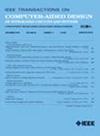Approx-T: Design Methodology for Approximate Multiplication Units via Taylor-Expansion
IF 2.9
3区 计算机科学
Q2 COMPUTER SCIENCE, HARDWARE & ARCHITECTURE
IEEE Transactions on Computer-Aided Design of Integrated Circuits and Systems
Pub Date : 2025-01-22
DOI:10.1109/TCAD.2025.3532845
引用次数: 0
Abstract
Approximate computing is emerging as a promising approach to devising energy-efficient IoT systems by exploiting the inherent error-tolerant nature of various applications. In this article, we present Approx-T, to tackle several major challenges according to the prior state-of-the-art (SOTA) approximate multiplication units (AMUs)—lack of comprehensive optimization formulation, asymmetric error distribution, nonadjustable runtime precision, and exponentially growing area complexity when adding up error compensation levels. We innovatively conduct an in-depth study on approximate multiplier via Taylor-expansion to address these issues. 1) Incorporate the Taylor’s theorem into the design concept of approximate arithmetic multipliers. 2) Leverage the inherent symmetrical error distribution of Taylor series to conduct unbiased approximations. 3) Present a runtime configurable error compensation architecture with low-complexity arithmetic operations. We implemented both approximate unsigned and signed integer and floating multiplication arithmetic units and compared with the SOTA works. The experimental results demonstrate that Approx-T surpasses other designs in all metrics, encompassing precision, area utilization, and power consumption. Furthermore, when deployed on an embedded field programmable gate array platform to assess a spectrum of edge computing tasks, Approx-T showcases remarkable performance. Particularly in CNN applications, it achieves up to a近似t:通过泰勒展开的近似乘法单元的设计方法
近似计算正在成为一种有前途的方法,通过利用各种应用固有的容错性来设计节能的物联网系统。在本文中,我们提出了approximate -t,根据现有的最先进的(SOTA)近似乘法单元(AMUs)来解决几个主要挑战-缺乏全面的优化公式,不对称的误差分布,不可调的运行时精度,以及在增加误差补偿水平时呈指数增长的面积复杂性。为了解决这些问题,我们创新性地通过泰勒展开对近似乘数进行了深入的研究。1)将泰勒定理纳入近似算术乘法器的设计概念。2)利用泰勒级数固有的对称误差分布进行无偏近似。3)提出了一种运行时可配置的低复杂度算术运算误差补偿体系结构。我们实现了近似无符号整数和有符号整数以及浮点乘法算术单元,并与SOTA的工作进行了比较。实验结果表明,about - t在所有指标上都优于其他设计,包括精度、面积利用率和功耗。此外,当部署在嵌入式现场可编程门阵列平台上以评估一系列边缘计算任务时,约x- t显示出卓越的性能。特别是在CNN应用中,它在能源效率方面提高了10.7倍,同时对准确性的影响可以忽略不计。
本文章由计算机程序翻译,如有差异,请以英文原文为准。
求助全文
约1分钟内获得全文
求助全文
来源期刊
CiteScore
5.60
自引率
13.80%
发文量
500
审稿时长
7 months
期刊介绍:
The purpose of this Transactions is to publish papers of interest to individuals in the area of computer-aided design of integrated circuits and systems composed of analog, digital, mixed-signal, optical, or microwave components. The aids include methods, models, algorithms, and man-machine interfaces for system-level, physical and logical design including: planning, synthesis, partitioning, modeling, simulation, layout, verification, testing, hardware-software co-design and documentation of integrated circuit and system designs of all complexities. Design tools and techniques for evaluating and designing integrated circuits and systems for metrics such as performance, power, reliability, testability, and security are a focus.

 求助内容:
求助内容: 应助结果提醒方式:
应助结果提醒方式:


